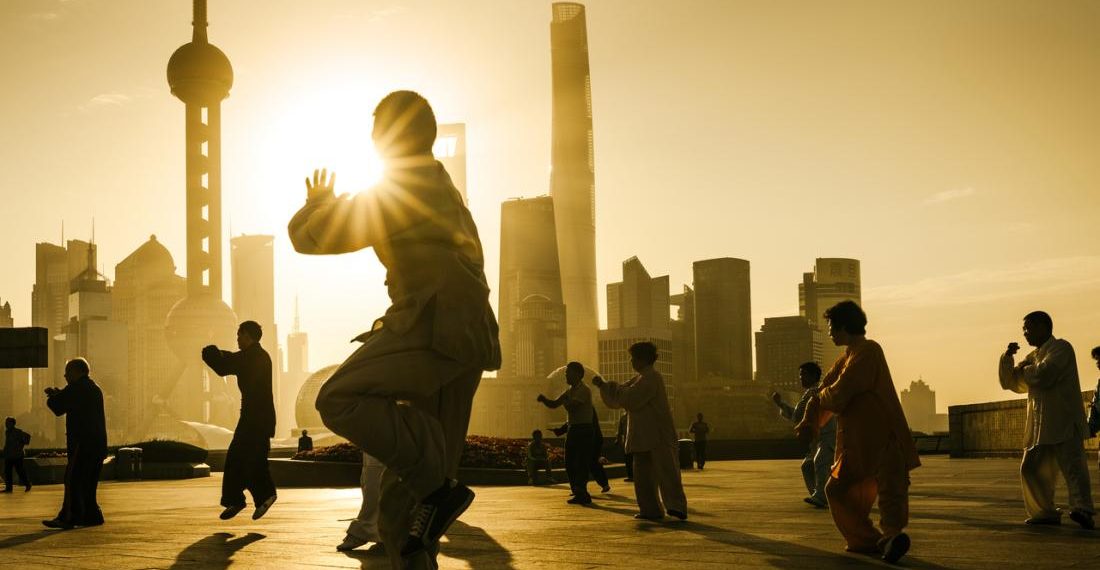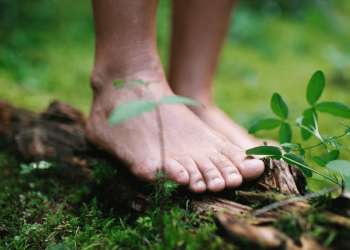In the gentle flow between motion and stillness lies a profound practice that has nourished body, mind, and spirit for centuries. Tai Chi walking meditation, often called “walking like a cat” or Taiji Zou, represents a beautiful synthesis of ancient Chinese movement arts and contemplative practice. Unlike the vigorous stride of exercise walking, this meditative approach transforms each step into a doorway to present-moment awareness, inviting practitioners to discover extraordinary depth in the simple act of walking.
The Philosophy Behind the Practice
Tai Chi walking meditation emerges from the same philosophical wellspring as Tai Chi Chuan itself—the Taoist understanding of natural harmony, balance, and the cultivation of qi (vital life energy). At its heart, this practice embodies the principle of wu wei, or effortless action, where movement flows with such naturalness that it seems to happen by itself, free from strain or forcing.
The practice asks us to walk as though we are moving through water—with awareness of resistance, with respect for the medium through which we move, and with a quality of fluid grace. This imagery captures something essential: we are not simply moving our bodies through empty space, but engaging in a rich sensory dialogue with our environment, our breath, and the subtle energies within us.
In traditional Chinese medicine and philosophy, walking meditation serves as a bridge between yin and yang energies. Standing meditation (Zhan Zhuang) is considered more yin—still, receptive, and deeply rooting. Seated meditation deepens this inward focus. Walking meditation, by contrast, balances these qualities with the yang aspects of movement, progression, and dynamic energy circulation. It becomes a moving stillness, an active rest.
The Meditative Essence
What distinguishes Tai Chi walking meditation from ordinary walking is the quality of attention brought to each moment. Rather than treating walking as merely a means to get somewhere, the practice invites us to recognize walking itself as the destination. Each step becomes complete in itself, a full expression of presence.
The meditative aspects manifest through several interwoven dimensions. First, there is body awareness—the heightened sensitivity to physical sensation, alignment, weight distribution, and the intricate coordination of muscles and joints. Practitioners learn to feel the kiss of the foot meeting earth, the subtle shift of weight from heel to toe, the opening and closing of the hip joint, and the spiraling engagement of the legs.
Second, breath awareness weaves through the movement, creating a rhythmic unity between respiration and locomotion. The breath becomes both anchor and wave, grounding us while carrying us forward. Some traditions coordinate specific breathing patterns with steps, while others allow a more organic synchronization to emerge naturally.
Third, there is mental stillness—the quieting of the constant mental chatter that typically accompanies our daily activities. As attention settles into the sensory richness of walking, thoughts begin to lose their grip. The mind, given something concrete and present to attend to, relaxes its habitual grasping and planning.
Finally, there is an opening to what might be called spacious awareness—a quality of consciousness that encompasses both the focused attention on walking and a peripheral openness to the broader field of experience. Sounds, sights, and sensations are noticed without pulling awareness away from the primary focus on movement.
Foundational Techniques
Beginning Tai Chi walking meditation requires patience and a willingness to slow down far more than might initially feel comfortable. The practice typically starts with establishing a solid foundation.
The Standing Meditation Prelude: Before taking the first step, practitioners often spend several minutes in Wu Ji stance—standing naturally with feet shoulder-width apart, knees slightly bent, weight evenly distributed, and arms hanging loosely at the sides. This preparatory stance allows the mind to settle, the breath to deepen, and awareness to gather in the body’s center of gravity, the dan tien, located approximately three finger-widths below the navel.
The Empty Step: The fundamental technique begins with what is called the “empty step” or “insubstantial step.” As you prepare to lift your foot, you first shift 100% of your weight onto the standing leg. This complete weight transfer is crucial—the foot that will step forward should become so light that it could be lifted without any additional shifting or adjustment. This teaches a fundamental principle: clear distinction between full and empty, weight-bearing and weightless.
The Heel-First Landing: As the foot moves forward, it travels low to the ground, as if skimming the surface of water. The heel touches down first, very gently, testing the ground like a cat checking uncertain terrain. There is no commitment yet, no dropping of weight. Only when the heel is secure does the rest of the foot gradually lower, rolling through the outer edge and then allowing the whole foot to settle.
The Weight Transfer: Once the front foot is fully planted, weight begins to shift forward with exquisite slowness. Imagine your weight as honey pouring from one leg to the other—thick, smooth, and continuous. The knees never lock; they remain slightly bent throughout, maintaining what practitioners call “living joints.”
The Back Foot Release: As weight settles completely onto the front leg, the back foot becomes progressively lighter until the heel can lift naturally, and finally the toes, preparing for the next step. The cycle repeats in an unbroken flow.
Cultivating Mindfulness While Walking
Mindfulness in Tai Chi walking develops through layered attention. Begin with the most obvious physical sensations, then gradually refine your awareness to include subtler dimensions.
Scanning Attention: As you walk, mentally scan through your body from the ground up. Feel the texture of the earth beneath your feet—is it soft, firm, cool, warm? Notice the articulation of your ankles, the strength in your calves, the opening through your hips. Allow attention to rise through the spine, which should feel lengthened and easeful, as though suspended from above. Notice your shoulders—are they creeping toward your ears? Let them soften and drop. Feel the weight of your arms swinging naturally, or held in a gentle curve as in traditional Tai Chi postures.
Breath Integration: Coordinate breath with movement in a way that feels natural. Some practitioners inhale as they lift the foot and shift weight forward, then exhale as the foot plants and weight settles. Others prefer the reverse. There is no single correct method—the breath should support movement without becoming forced or artificial. Over time, the breath may naturally lengthen and deepen, settling into a slow, abdominal rhythm.
The Principle of Rooting and Rising: With each step, cultivate simultaneous attention to two directions—downward rooting and upward lengthening. As the foot plants and weight settles, imagine roots growing deep into the earth, drawing up stable, nourishing energy. Simultaneously, feel the crown of the head lifting gently skyward, creating length through the spine. This dual awareness prevents collapse and maintains the dynamic equilibrium essential to Tai Chi.
Peripheral Awareness: While maintaining focus on the immediate sensations of walking, allow your awareness to include peripheral information without becoming distracted by it. Birds singing, traffic sounds, the quality of light, the temperature of air on your skin—all become part of the meditative field without fragmenting your attention.
Deepening the Practice
As the basic mechanics become more familiar, several approaches can deepen your Tai Chi walking meditation.
Extreme Slowness: One of the most powerful methods for deepening presence is to walk so slowly that each step takes thirty seconds to a minute or more. This pace reveals every micro-movement, every subtle adjustment of balance, every moment where the mind wanders or attention wavers. It builds extraordinary patience and concentration while exposing habits of rushing that may pervade your life.
Energy Awareness: As your practice matures, begin to notice not just physical sensation but the more subtle felt sense of energy movement. Can you feel qi sinking to the soles of your feet with each grounded step? Can you sense energy rising up the spine as you lengthen? Do you notice a gathering of warmth or vitality in the lower abdomen? This dimension cannot be forced—it emerges naturally as the body relaxes and sensitivity increases.
Walking with Imagery: Traditional Tai Chi employs rich imagery to guide movement quality. Walk as though you are parting curtains of silk with your hands and body. Move as though you are in water, feeling its gentle resistance. Imagine you are carrying a precious bowl of water on your head that must not spill. These images, rather than being mere metaphors, actually change the quality of movement and attention.
Integration with Standing Forms: Once comfortable with basic walking, you might incorporate simple Tai Chi hand movements—gentle arcing motions, the “holding the ball” posture, or wave hands like clouds. The coordination of upper and lower body, maintaining fluid continuity while managing multiple areas of attention, significantly deepens concentration and body awareness.
Varying Terrain: While beginners benefit from flat, even surfaces, advancing practitioners can explore walking meditation on different terrains—grass, sand, gentle slopes, or winding paths. Each terrain offers different challenges and opportunities for maintaining presence and balance.
The Fruits of Practice
With regular practice, Tai Chi walking meditation yields profound benefits. Physically, it develops balance, leg strength, joint health, and refined proprioception—the sense of where your body is in space. The slow, mindful movement creates time for the nervous system to integrate and refine motor patterns, often correcting postural imbalances that develop from modern sedentary lifestyles.
Mentally, the practice offers a respite from the relentless acceleration of contemporary life. It trains the capacity to be present, to move through life with awareness rather than automaticity. This quality of presence naturally extends beyond formal practice into daily activities—walking to your car, climbing stairs, moving through your home.
Emotionally and spiritually, many practitioners discover that the simple act of walking with full presence becomes a gateway to deeper peace and connection. The practice dissolves the artificial boundary between meditation and action, revealing that every moment, every movement can be an expression of awakened awareness.
Conclusion: Walking the Way
Tai Chi walking meditation is not merely a technique to be mastered but a way of being to be embodied. It asks us to bring quality over speed, depth over distance, presence over distraction. In a world that constantly urges us to rush, to get ahead, to optimize and accelerate, this practice offers a radical alternative: to be fully where we are, to walk the earth with reverence and attention, and to discover that each step, taken with awareness, is already complete.
The ancient Chinese sage Laozi taught that “a journey of a thousand miles begins with a single step.” In Tai Chi walking meditation, we discover something even more profound—that the single step, fully experienced, contains the entire journey.
- what is tai chi walking meditation
- comprehensive meditation techniques
- mindful meditation practice
- finding stillness in movement
- benefits of walking meditation
- beginner’s meditation guide
- mindfulness in meditation walking
- mind-body meditation connection
- chi energy in meditation
- intentional meditation practice






